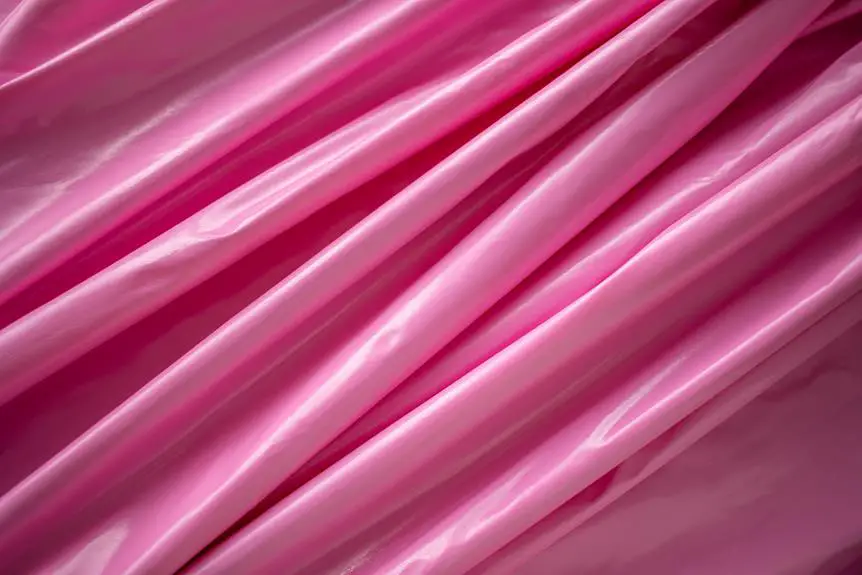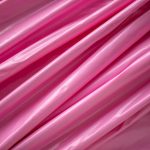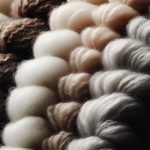When considering the best base dye for your fabric, it's essential to note that over 36% of textile dyeing worldwide is done using reactive dyes.
Understanding the factors influencing dye selection is crucial in achieving the desired colorfastness and vibrancy for different fabrics. Whether dyeing cotton, synthetic, wool, silk, or blended fabrics, each type requires specific considerations to achieve optimal results.
This guide will provide you with a comprehensive understanding of the different base dyes and their suitability for various fabric types, empowering you to make informed decisions and master the art of fabric dyeing.
Key Takeaways
- The choice of base dye for fabric depends on the type of fabric being dyed.
- Different dyeing techniques like immersion dyeing, tie-dye, and shibori create unique outcomes.
- Natural fibers like cotton and silk often require different dyes than synthetic fibers.
- Careful adherence to dyeing instructions and techniques ensures consistent results.
Understanding Different Base Dyes
When choosing a dye for your fabric, you should consider the different types of base dyes available and how they interact with various fabrics. Base dye characteristics play a crucial role in determining the final color and durability of the dyed fabric.
Acid dyes, for example, work best on protein-based fibers like wool and silk, while direct dyes are suitable for cotton and rayon. On the other hand, fiber-reactive dyes are ideal for cellulose-based fibers such as cotton and linen. Understanding the specific characteristics of each base dye is essential for achieving the desired color vibrancy and wash-fastness.
In addition to base dye characteristics, different dyeing techniques also impact the outcome of the dyed fabric. For instance, immersion dyeing involves submerging the fabric in a dye bath, ensuring an even color distribution. Meanwhile, tie-dye and shibori techniques create unique patterns by manipulating the fabric before dyeing.
Factors Influencing Dye Selection
To select the most suitable dye for your fabric, it's important to consider various factors that influence the dye selection.
Factors influencing dye selection include the type of fabric you're dyeing, as different dyes are more compatible with certain fabrics. For instance, natural fibers like cotton and silk often require different dyes than synthetic fibers such as polyester.
The desired color outcome also plays a crucial role in dye selection. Some dyes are better suited for achieving vibrant, bold colors, while others are more suitable for pastel or muted shades.
Additionally, the intended dyeing technique can impact the choice of dye. Certain dyes are specifically formulated for techniques like tie-dyeing or batik, while others are better suited for traditional immersion dyeing methods.
Dyeing Cotton Fabrics
After considering the factors influencing dye selection, you can now focus on dyeing cotton fabrics, which are commonly found in clothing and home textiles. When dyeing cotton, you have the option to use natural dyes, which are eco-friendly alternatives to synthetic dyes. Natural dye options like indigo, madder root, and turmeric can produce a wide range of colors and are sustainable choices for environmentally conscious consumers.
Color fastness and durability are crucial factors to consider when dyeing cotton fabrics. Cotton has a high affinity for dyes but may require mordants to improve color retention. Additionally, selecting dyes that have good wash and light fastness will ensure that the dyed cotton fabric maintains its vibrancy and color intensity over time. It's also important to consider the fabric's durability, as some dyes may affect the strength and integrity of the cotton fibers.
When dyeing cotton fabrics, it's essential to carefully follow the dyeing instructions and use proper dyeing techniques to achieve consistent and long-lasting results. Whether opting for natural dye options or synthetic dyes, ensuring color fastness and durability will help you achieve high-quality, beautifully dyed cotton fabrics.
Dyeing Synthetic Fabrics
Select the appropriate synthetic dye based on the fabric type and desired color, ensuring compatibility and vibrant results.
When dyeing synthetic fabrics, it's crucial to address the challenges unique to this type of material. Synthetic fabrics, such as polyester, nylon, and acrylic, are non-porous, which can make dye absorption difficult. To overcome this, consider using disperse dyes specifically formulated for synthetic fibers. These dyes are designed to penetrate the surface of the fabric and bond with the fibers, resulting in long-lasting color.
When dyeing synthetic fabrics, it's important to employ specific techniques to ensure optimal results. Unlike natural fibers, synthetic fabrics require higher heat settings to facilitate dye absorption. Additionally, using a dye carrier, such as a liquid medium, can aid in dispersing the dye evenly across the fabric. Preparing the fabric by thoroughly washing it with a detergent that doesn't contain fabric softener or bleach is also essential to remove any coatings that may hinder dye penetration.
Dyeing Wool and Silk
When dyeing wool and silk, it's important to consider the options available for each fabric. Wool dyes are specifically formulated to work with the unique properties of wool, while silk dyes are designed to enhance the lustrous nature of silk.
Understanding the compatibility of dyes with these fabrics is crucial for achieving the best results in your dyeing projects.
Wool Dye Options
You can achieve vibrant and long-lasting color on wool and silk by using the right dye option.
When it comes to dyeing wool, there are various options available to achieve the desired results. Here are some popular dye options for wool and silk:
- Acid Dyes: These dyes are highly effective for wool and silk, offering a wide range of vibrant colors.
- Natural Dyes: Extracted from plants, these dyes provide a more eco-friendly option, resulting in unique and earthy tones.
- Fiber Reactive Dyes: Ideal for silk, these dyes create colorfast and bright hues, perfect for achieving a modern look.
- Union Dyes: Suitable for both wool and silk, these dyes offer good color retention and uniform dyeing results.
- Metal Complex Dyes: Known for their excellent wash and lightfastness, these dyes provide long-lasting color on wool and silk.
Consider these options to achieve stunning results when dyeing wool and silk.
Silk Dye Considerations
For achieving vibrant and long-lasting color on silk, consider using the right dye option. Silk dyeing requires delicate handling to preserve the fabric's natural luster and softness. When dyeing silk, it's essential to choose dyes specifically formulated for delicate fabrics.
Acid dyes are commonly recommended for silk due to their ability to produce intense, long-lasting colors without damaging the fabric. Additionally, silk dyeing techniques such as hand painting, dip-dyeing, or low-temperature immersion dyeing can be used to achieve unique and varied color effects.
Prior to dyeing, ensure the silk fabric is clean and free from any finishes that may resist the dye. Proper preparation and application of the dye are crucial for achieving vibrant, even color on silk while preserving the fabric's delicate nature.
Compatibility With Fabrics
To ensure vibrant and long-lasting colors on delicate fabrics like wool and silk, it's important to choose dyes specifically formulated for these materials. When dyeing wool and silk, consider the following:
- Dyeing Techniques: Use appropriate dyeing techniques such as immersion dyeing or hand painting to ensure even color distribution and minimize damage to delicate fibers.
- Fabric Types: Understand the specific properties of wool and silk to determine the most suitable dyeing process for each fabric type.
- Color Fastness: Select dyes that offer excellent color fastness to prevent fading and ensure the longevity of the dyed fabrics.
- Dye Penetration: Opt for dyes that can effectively penetrate the fibers of wool and silk to achieve deep, rich colors without compromising the fabric's integrity.
- Compatibility Testing: Always conduct compatibility tests to assess how different dyes interact with wool and silk, ensuring the best results.
Dyeing Blended Fabrics
When dyeing blended fabrics, it's essential to consider the best base dye for optimal color results. The compatibility of the fabric and dye is crucial to achieving the desired color and ensuring the dye adheres effectively.
Understanding the intricacies of blended fabric dyeing will help you achieve professional and long-lasting results.
Blended Fabric Dyeing
When dyeing blended fabrics, there are several factors to consider.
Firstly, it is important to choose a dye that will work well with the different types of fibers present. Blended fabrics contain a mix of fibers like cotton, polyester, rayon, or wool, so finding a dye that is suitable for all of them is essential.
In addition, color consistency is another consideration. You want to look for a dye that will produce consistent color across the different fibers in the blend. This will ensure that the final result is even and cohesive.
Durability is also important when dyeing blended fabrics. Opt for a dye that ensures longevity and color fastness. This will help to maintain the fabric's appearance over time, preventing color fading or bleeding.
Consider the fabric's care requirements as well. Select a dye that aligns with these requirements to preserve the quality of the fabric. Some dyes may require special care instructions or additional steps to ensure the best results.
Finally, it's crucial to consider the specific dyeing techniques suitable for blended fabrics. Different techniques may yield different results, so it's important to choose the method that will help you achieve the desired outcome.
Best Base Dye
For dyeing blended fabrics, choose a base dye that caters to the different fibers in the blend for optimal color consistency and durability. When dyeing blended fabrics, it's essential to consider the dye penetration and color fastness on each type of fiber in the blend. Look for a base dye that can effectively penetrate and bond with both synthetic and natural fibers to ensure even coloration and long-lasting vibrancy.
Additionally, consider the environmental impact and cost-effectiveness of the base dye. Opt for dyes that minimize environmental harm through eco-friendly production methods and waste management. Cost-effectiveness should also be taken into account, balancing the quality and price of the base dye for a sustainable and economical dyeing process.
Fabric Dye Compatibility
How can you ensure that the base dye you choose effectively penetrates and bonds with both synthetic and natural fibers in blended fabrics for consistent coloration and lasting vibrancy? When dyeing blended fabrics, it's crucial to consider dye compatibility to achieve optimal results.
To ensure successful coloration and color fastness, follow these essential guidelines:
- Select dyes specifically formulated for blended fabrics.
- Use dyeing techniques suitable for both synthetic and natural fibers.
- Prioritize proper fabric care to maintain color vibrancy.
- Pay attention to dye application methods for even and thorough penetration.
- Test color fastness before full-scale dyeing to avoid potential issues.
Special Considerations for Natural Fabrics
You frequently encounter challenges when dyeing natural fabrics, such as cotton and silk, due to their inherent properties. When considering plant-based fabrics, it's important to recognize that natural dyes, such as indigo, turmeric, and madder, are well-suited for these materials.
Not only do natural dyes offer a wide range of colors, but they also provide a sustainable and environmentally friendly alternative to synthetic dyes. However, it's crucial to acknowledge that natural dyes may not always offer the same level of color fastness as synthetic dyes. Therefore, when dyeing natural fabrics with natural ingredients, it's essential to explore techniques to enhance color retention, such as mordanting and proper post-dye treatments.
Furthermore, the environmental impact of natural dyes should be considered. While they're derived from renewable resources and biodegradable, the cultivation and extraction processes can have environmental implications. It's vital to seek out natural dyes that are sourced and produced in an eco-friendly and sustainable manner to minimize any adverse effects on the environment.
When dyeing natural fabrics, a thoughtful and informed approach to selecting and using natural dyes can lead to vibrant, long-lasting colors while minimizing the environmental impact.
Frequently Asked Questions
Can Base Dyes Be Used to Dye Non-Fabric Materials Such as Leather or Wood?
Yes, base dyes can be used to dye non-fabric materials such as leather or wood. By utilizing the appropriate base dye and following proper application techniques, you can achieve vibrant and long-lasting color results on these materials.
Are There Any Environmental Considerations to Take Into Account When Choosing a Base Dye for Fabric?
When choosing a base dye for fabric, it's important to consider the environmental impact. Look for sustainable options that minimize water usage, use non-toxic ingredients, and employ eco-friendly production processes to reduce harm to the environment.
How Do Different Base Dyes Affect the Durability and Wash-Fastness of the Fabric?
Different base dyes impact fabric durability and color vibrancy. When selecting a dye, consider how it affects wash-fastness and overall care for the fabric. Understanding the impact of dye selection is crucial for fabric longevity.
Can Base Dyes Be Used to Create Unique Effects Such as Tie-Dye or Ombre on Fabric?
Yes, base dyes can be used to create unique effects like tie-dye and ombre on fabric. By carefully applying and blending different concentrations of base dyes, you can achieve stunning tie-dye techniques and beautiful ombre effects.
Are There Any Specific Safety Precautions or Handling Instructions for Using Different Types of Base Dyes on Fabric?
When using different types of base dyes on fabric, it's crucial to follow safety precautions and handling guidelines. Always wear gloves, work in a well-ventilated area, and carefully follow the fabric dyeing safety and handling instructions for best results.
- Ivory Chamois Fabric: Style and Application Guide - June 22, 2025
- Winterfleece Micro Chamois White Fabric: Uses and Benefits - June 22, 2025
- Clarksville Chamois Fabric: A Detailed Overview - June 22, 2025






